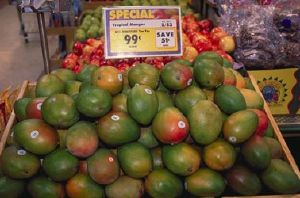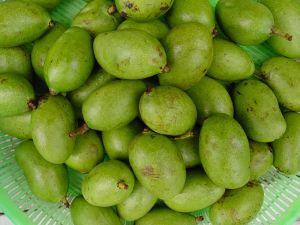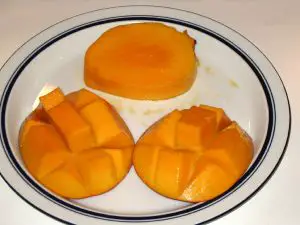Mango
| Mango | ||||||||||||
|---|---|---|---|---|---|---|---|---|---|---|---|---|
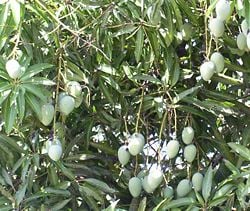 Immature Black Mango fruit | ||||||||||||
| Scientific classification | ||||||||||||
| ||||||||||||
| Species | ||||||||||||
|
About 35 species, including: |
The mango (plural mangos or mangoes) is a genus, Mangifera, of about 35 species of tropical fruiting trees in the flowering plant family Anacardiaceae (cashew or poison ivy family). Mango also refers to the mango fruit of these trees, but in particular to the fruit of the species Mangifera indica, which provides the most commercially important fruit crop. Up to 15 other Mangifera species besides M. indica produce edible fruit, including the water mango M. laurina, and the wild, forest mango, M. sylvatica, from which M. indica is thought to have descended. The family Anacardiaceae, which is characterized by resinous bark and caustic oils in leaves, bark, and fruits, contains 73 genera and about 600 to 700 species, including cashew, pistachio, and the mombins.
The mango tree originated in the Indo-Burma region, where it is still found growing wild in forests, especially in the hilly areas of the northeast. Artificial selection of wild types has occurred for 4000-6000 years, and vegetative propagation for at least 400 years in India. The ancient Hindu texts, the Vedas and the Puranas, written as far back as 2000 B.C.E., are replete with references to the mango. One of the earliest Hindu myths claims that the tree is the very transformation of Prajapati, the progenitor and creator of all creatures.
The mango is a very popular fruit, so much so that it has been hailed as the "king of fruits"; in the Hindu Vedas, the mango is referenced as the "food of the gods." The mango also is a nutritional fruit, containing valuable vitamins, minerals, enzymes, and antioxidants. But the popularity of the mango goes beyond dietary considerations, and includes more internal values. The Buddha found mango groves to be an attractive place for meditation, Hindus use mango twigs on holy days, and the mango tree continues to serve as a symbol of love and life. Other internal values include the pleasure from the diverse tastes, textures, and colors of mango fruits, and both the tree and fruit have been the focus of works of art. The many varieties of mango, created by people and cultivated over the centuries, demonstrates the creativity of humans, as does the multitude of different preparation methods for the consumption of the fruit.
The name "mango" is derived from the Tamil word mangaai, and was popularized by the Portuguese after their Indian exploration, hence the word 'manga' in Portuguese. Today, the mango is widely cultivated as a fruit tree in frost-free tropical and subtropical climates throughout India, North America, Central America, South America, the Caribbean, south and central Africa, and Australia.
Characteristics
Mango trees are large trees, reaching ten to 30 meters (30 to 100 feet) in height, with a broad, rounded canopy that may, with age, attain 30 to 38 meters (100-125 feet) in width, or with a more upright, oval, slender crown. The mango tree is known for its longevity, with some specimens being noted to still bear fruit at 300 years of age. Leaves are lanceolate to linear, glossy evergreen in color, and have prominent light colored veins and entire margins. Emerging leaves on new growth flushes are bronze-red before maturation and appear wilted. One or two growth flushes occur per year, with flushes appearing sporadically across the tree's canopy. Fully grown leaves may be ten to 32 cm long and two to five cm broad, and may persist for several years.
Tiny, red-yellow flowers are borne in profuse, pyramidal, branched clusters of hundreds to as a many as four thousand individuals. Terminal panicles (type of flower cluster) are six to 40 cm long. The flowers give off a mild sweet odor suggestive of lily of the valley, and 25 to 95 percent of the flowers are male, while the rest are hermaphroditic. Panicles sprouting in the bloom season or in shaded parts of the canopy tend to have more hermaphroditic flowers. Flowering occurs one to three months after panicles are initiated in terminal buds and are triggered by low temperatures or seasonally dry conditions. Chemical application of ethepon, KNO3, and naphthalene acetic acid (NAA) is used to either induce flowering, or enhance the proportion of hermaphroditic flowers.
Mango trees are considered to be self-fertile and do not require pollinizers, although research does indicate that some cultivars are self-unfruitful or at least benefit from cross-pollination. Pollination is achieved mostly by wild insects, and to a lesser extent, by honeybees. Although there may be up to four thousand flowers on a panicle, the fruit is usually just a few percent, with an average of one mango borne per panicle. After the flowers bloom, the fruit takes from three to six months to ripen. Fruiting begins within six to ten years for seedling trees, and three to five years for grafted trees.
Fruit
The mango fruit is a drupe, that is, one in which an outer fleshy part surrounds a shell (the pit or stone) of hardened endocarp with a seed inside. When mature, the mango fruit hangs from the tree on long stems. Mangos are variable in size, from six to 25 cm long, seven to 12 cm wide, and with a weight of up to 2.5 kg (four to five lbs). The ripe fruit is variably colored yellow, orange, and red—reddest on the side facing the sun and yellow in the shade. Green usually indicates that the fruit is not yet ripe, but this depends on the cultivar, or variety. Some mangos have a turpentine odor and flavor, while others have a rich and pleasant fragrance. The flesh ranges from pale yellow to deep orange and is extremely juicy, with a flavor range from very sweet to subacid to tart.
In the center of the fruit is a single flat, oblong stone that can be fibrous or hairless on the surface, depending on the cultivar. Inside the shell, which is one to two mm thick, is a paper-thin lining covering a starchy seed that is either monoembryonic (usually single-sprouting) or polyembryonic (usually producing more than one seedling).
The prime climate for mango cultivation is seasonally wet and then seasonally dry (or vice versa) climate zones of the lowland tropics, or frost-free subtropical areas. A dry and cool season causes uniform floral initiation and, importantly, synchronizes bloom and harvest. Temperatures below 60° or above 100° F at flowering may cause flower abortion, loss of pollen viability, and occasionally seedless fruit development. Fruit growth never becomes dormant; however, it does cease at temperatures below 55-60° F.
Cultivars
There are hundreds of mango cultivars (a named grouping of cultivated plants sharing particular attributes) that exist throughout the world. In mango orchards, several cultivars are usually grown intermixed to improve cross-pollination. Many mango cultivars were derived from chance seedlings, but some of the most commercially-popular cultivars were founded at a breeding program in Florida.
There are two classes of cultivars: Indochinese and Indian. The mangos of the Indochinese group are described as flattened, kidney-shaped, and oblong with light green or yellow skin, and little or no red color. Indochinese cultivars usually have a polyembryonic seed, and most are resistant to anthracnose, the major fungal disease affecting the mango. In contrast, the Indian class is characterized by mangos that are more plump and rounded, and that have a bright red blush on the skin. Indians mangos have a monoembryonic seed that facilitates breeding efforts, and are commonly susceptible to anthracnose.
Today, even though each producing country has its own group of cultivars, Indian cultivars originally bred in Florida dominate the export market. Through the late 1930s and early 1940s, "Haden," which was a chance seedling of "Mulgoba" (one of the original mango cultivars brought from India to the U.S. by the USDA in the 1800s), was the most popular cultivar. "Haden," however, was found to be anthracnose-prone, and a light and irregular bearer, and since then has been replaced by more disease-resistant and prolific cultivars. The leading present-day mango cultivars for commercial production and shipping are "Tommy Atkins," "Keitt," "Kent," "Van Dyke," and "Jubilee." The first two cultivars represent 50 percent of commercial crop.
Production
| Top 12 Mango Producers - 2005 (hectares) | |
|---|---|
| India | 1,600,000 |
| China | 433,600 |
| Thailand | 285,000 |
| Indonesia | 273,440 |
| Mexico | 173,837 |
| Philippines | 160,000 |
| Pakistan | 151,500 |
| Nigeria | 125,000 |
| Guinea | 82,000 |
| Brazil | 68,000 |
| Vietnam | 53,000 |
| Bangladesh | 51,000 |
| World Total | 3,870,200 |
| Source: UN Food & Agriculture Organisation (FAO) | |
India, China, and Thailand are the world's three largest producers. As of 2005, India was the largest producer, with an area of 1.6 million hectares with an annual production of 10.8 million tons, which accounted for 57.18 percent of the total world production. The state of Uttar Pradesh dominates the mango production in the North, and it is considered the most important fruit in central and eastern part of the state, from Lucknow to Varanasi, which produce some of the finest varieties. In southern India, Andhra Pradesh and Karnataka states are major producers of mangos and specialize in making a variety of mango pickles. These pickles are very spicy. It is almost an essential food in Andhra families, where mango pickle production is a household activity in summer.
In the United States, Florida and Hawaii are the predominant producers, with Florida responsible for more than 90 percent of production and 80 percent of acreage. The U.S. however imports about 100 times the domestic production, with most fruit coming from Mexico, and small amounts from Brazil, Guatemala, and Haiti.
Consumption
Mangos should always be washed to remove any sap or residue on the skin before handling. Since the mango is in the same family as poison ivy, it is not surprising that sap from the mango tree contains the hazardous chemical urushiol, although much less than poison ivy. Some people get dermatitis from touching mango sap or peel.
Some seedling mangos are so fibrous that they cannot be sliced. These mangos are first massaged by rolling on a flat surface, and then a piece of skin at the top of the mango is ripped off and the mouth placed over the hole. The mango is squeezed from bottom up into the mouth. On the other hand, non-fibrous mangos may be cut in half to the stone.
Generally, once ripe, mangos are quite juicy and can be very messy to eat. However, those exported to temperate regions are, like most tropical fruit, picked under-ripe. Although they are ethylene producers and ripen in transit, they do not have the same juiciness or flavor as the fresh fruit. A ripe mango will have an orange-yellow or reddish skin. To allow a mango to continue to ripen after purchase, it should be stored in a cool, dark place, but not in a refrigerator as this will slow the ripening process.
Green mangos are similar to the green apples of more temperate zones; they are tart, crisp, and somewhat dry. Many people like to eat unripe mangos with salt (which are extremely sour; much more than lemon), and in regions where food is hotter, with salt and chili.
The mango has proven itself to be a versatile food commodity all around the world. Twenty-five percent of mangos are processed into juices, chutneys, sauces, or served dried. The mango seed can be processed into a flour. During food shortages in India, the kernels are sometimes steeped in hot water to dispel the tannins, dried, and then ground into a flour that is mixed with wheat or rice flour to make bread. The fat extracted from the kernel is a white, edible tallow that has been proposed as a substitute for cocoa butter in chocolate.
Ripe mangos are extremely popular throughout Latin America. In Mexico, sliced mango is eaten with chili powder and/or salt. Street vendors sometimes sell whole mangos on a stick, dipped in the chili-salt mixture. In Guatemala, Ecuador, Nicaragua, and Honduras, small, green mangos are popular; they have a sharp, brisk flavor like a Granny Smith apple. Vendors sell slices of peeled green mango on the streets of these countries, often served with salt.
Mangos are widely used in chutney (type of condiment), which in the West is often very sweet, but in the Indian subcontinent is usually sharpened with hot chilis or limes. In India, ripe mango is often cut into thin layers, desiccated, folded, and then cut and sold as bars. These bars, known as amavat in Hindi, are similar to dried Guava fruit bars available in [Colombia]].
In the Philippines, unripe mango is eaten with bagoong, a fermented minute shrimp paste that comes in sweet, salty, and spicy flavors. Dried strips of sweet, ripe mangos have also gained popularity both inside and outside the country, with those produced in Cebu making it to export markets around the world.
Mango is also used to make juices, both in ripe and unripe form. Pieces of fruit can be mashed and used in ice cream, pie, or put in a blender with milk, a little sugar, and crushed ice for a beverage. A more traditional Indian drink is mango lassi, which is similar, but uses a mixture of yogart and milk as the base, and is sometimes flavored with salt or cardamom. In Thailand and other South East Asian countries, sweet glutinous rice is flavored with coconut then served with sliced mango on top as a dessert.
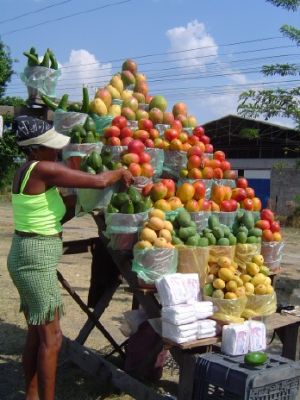
Dried unripe mango used as a spice in south and southeast Asia is known as amchur (sometimes spelled amchoor). Am is a Hindi word for Mango and amchoor is powder or extract of Mango.
Green mangos may be used in the sour salad called rujak in Indonesia, and rojak in Malaysia and Singapore. In Hawaii, it is common to pickle green mango slices.
The Sweet Bell Pepper (capsicum) is also sometimes known as mango in parts of the midwestern United States. With the advent of fresh fruit importers exposing individuals to the tropical fruit, the colloquial use of this alternative name for the Sweet Bell Pepper is becoming archaic, although many midwestern menus will still offer stuffed mangos as an entree.
Contribution to Diet
Mangos have a high sugar content, but are low in fat, and are excellent sources of beta-carotene and beta-cryptoxanthin. Both carotenoids are converted to active forms of vitamin A in the body; however, beta-cryptoxanthin is about two times less strong than beta-carotene. The total carotenoids in mangos increase with the stage of ripening. Since beta-cryptoxanthin is best absorbed by the body when eaten with fat, mangos should be eaten as part of a meal rather than on their own to maximize health benefits. Eating mangos throughout the season may build a store of vitamin A in the liver. Both ripe and unripe mangos are good sources of vitamin C. Both vitamins A and C are anti-oxidants that eliminate free radicals in the body and thus reduce the risk of certain cancers.
Mangos also contain an enzyme that provide aid in digestion, through breaking down proteins, and enzymes that stimulate metabolism and help with intestinal cleansing. Mangos have various phenols that are considered to have antioxidant and anticancer properties, and help prevent cardiovascular disease.
The high iron content in mangos are considered to help anemia and replace iron lost through menstruation and pregnancy, and potassium and magnesium that help with problems related to muscle cramps, stress, acidosis, and heart problems.
Nutrition Facts: Serving Size 1/2 mango (104g)
- Calories 70
- Total Fat 0.5g
- 1 percent Daily Value
- Cholesterol 0mg
- 0 percent Daily Value
- Sodium 0mg
- 0 percent Daily Value
- Total Carbohydrate 17g
- 6 percent Daily Value
- Dietary Fiber 1g
- Sugars 16g
- Protein 0g
- Vitamin A 40 percent Daily Value
- Vitamin C 15 percent Daily Value
- Calcium 0 percent Daily Value
- Iron 0 percent Daily Value
Percent Daily Values are based on a 2,000 calorie diet. Daily values may be higher or lower depending on calorie needs. Source: PMA’s Labeling Facts.
The mango in culture
Beyond the nutritional value and the pleasure of taste and sight, the mango has also been revered in culture. The mango fruit itself has been called the "king of fruits," and a reference to mangos as the "food of the gods" can be found in the Hindu Vedas. In India, the mango is considered as a wish-fulfilling tree and often viewed as a symbol of love and love, and is commonly associated with ideas of fertility and fecundity. At wedding ceremonies, the couple may be presented with mango leaves, to ensure many children, and to announce the birth of a child, neighbors decorate doorways with mango leaves. Archways of houses may also be decorated with mangos when a wedding occurs or new house constructed.
Buddha was said to be fond of meditation in mango groves, and on holy days, mango twigs are used by Hindus to brush their teeth.
The mango is also popular in the arts. The common artistic motif, the paisley design, found on Indian textiles, is a representation of the mango. It was one of the oldest patterns, if not the oldest pattern, used by the European weaving industry. French Impressionist Paul Gauguin also used the mango as the focus of some well-known paintings.
ReferencesISBN links support NWE through referral fees
- Budhwar, K. 2002. Romance of the Mango: The Complete Book of the King of Fruits. New Delhi: Penguin Books India.
- F & S Produce Company. 2006. Mangos Nutrition Facts Retrieved August 1, 2006.
- Ismael, M. K. 2006. Mango: The King of Fruits Bawarchi Health and Nutrition. Retrieved August 1, 2006.
- Morton, J. F. 1987. Fruits of Warm Climates. Miami: Creative Resource Systems.
- Phytochemicals.info. 2006. Phytochemicals, Beta-crptozanthin Retrieved August 1, 2006.
Credits
New World Encyclopedia writers and editors rewrote and completed the Wikipedia article in accordance with New World Encyclopedia standards. This article abides by terms of the Creative Commons CC-by-sa 3.0 License (CC-by-sa), which may be used and disseminated with proper attribution. Credit is due under the terms of this license that can reference both the New World Encyclopedia contributors and the selfless volunteer contributors of the Wikimedia Foundation. To cite this article click here for a list of acceptable citing formats.The history of earlier contributions by wikipedians is accessible to researchers here:
The history of this article since it was imported to New World Encyclopedia:
Note: Some restrictions may apply to use of individual images which are separately licensed.
